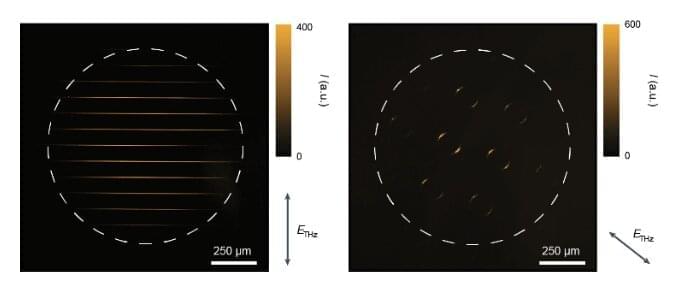Data security — information security newspaper | hacking news.
Get the latest international news and world events from around the world.
Flipping the switch: Scientists shed new light on genetic changes that turn ‘on’ cancer genes
Cancer, caused by abnormal overgrowth of cells, is the second-leading cause of death in the world. Researchers from the Salk Institute have zeroed in on specific mechanisms that activate oncogenes, which are altered genes that can cause normal cells to become cancer cells.
Cancer can be caused by genetic mutations, yet the impact of specific types such as structural variants that break and rejoin DNA, can vary widely. The findings, published in Nature on December 7, 2022, show that the activity of those mutations depends on the distance between a particular gene and the sequences that regulate the gene, as well as on the level of activity of the regulatory sequences involved.
This work advances the ability to predict and interpret which genetic mutations found in cancer genomes are causing the disease.


A new computational system streamlines the design of fluidic devices
Combustion engines, propellers, and hydraulic pumps are examples of fluidic devices—instruments that utilize fluids to perform certain functions, such as generating power or transporting water.
Because fluidic devices are so complex, they are typically developed by experienced engineers who manually design, prototype, and test each apparatus through an iterative process that is expensive, time-consuming, and labor-intensive. But with a new system, users only need to specify the locations and speeds at which fluid enters and exits the device. The computational pipeline then automatically generates an optimal design that achieves those objectives.
The system could make it faster and cheaper to design fluidic devices for all sorts of applications, such as microfluidic labs-on-a-chip that can diagnose disease from a few drops of blood or artificial hearts that could save the lives of transplant patients.

A room-temperature terahertz camera based on a CMOS and quantum dots
Terahertz (THz) radiation is electromagnetic radiation ranging from frequencies of 0.1 THz to 10 THz, with wavelengths between 30μm and 3mm. Reliably detecting this radiation could have numerous valuable applications in security, product inspection, and quality control.
For instance, THz detectors could allow law enforcement agents to uncover potential weapons on humans or in luggage more reliably. It could also be used to monitor natural environments without damaging them or to assess the quality of food, cosmetics and other products.
Recent studies introduced several devices and solutions for detecting terahertz radiation. While a few of them achieved promising results, their performance in terms of sensitivity, speed, bandwidth and operating temperature is often limited. Researchers at Massachusetts Institute of Technology (MIT), University of Minnesota, and other institutes in the United States and South Korea recently developed a new camera that can reliably detect THz radiation at room temperature, while also characterizing its so-called polarization states. This camera, introduced in a paper published in Nature Nanotechnology, is based on widely available complementary metal-oxide-semiconductors (CMOS), enhanced using quantum dots (i.e., nm-sized semiconductor particles with advantageous optoelectronic properties).

Hubble detects ghostly glow surrounding our solar system
Imagine walking into a room at night, turning out all the lights and closing the shades. Yet an eerie glow comes from the walls, ceiling, and floor. The faint light is barely enough to see your hands before your face, but it persists.
Sounds like a scene out of “Ghost Hunters?” No, for astronomers this is the real deal. But looking for something that’s close to nothing is not easy. Astronomers searched through 200,000 archival images from Hubble Space Telescope and made tens of thousands of measurements on these images to look for any residual background glow in the sky.
Like turning out the lights in a room, they subtracted the light from stars, galaxies, planets and the zodiacal light. Surprisingly, a ghostly, feeble glow was left over. It’s equivalent to the steady light of ten fireflies spread across the entire sky.

New electrochemical measurement output uses data science to reveal microbial electricity generation mechanisms
Researchers at Japan’s National Institute for Materials Science (NIMS) have developed a device capable of taking hundreds of times more electrochemical measurements than conventional devices. By analyzing the device’s large amounts of data, the team has identified molecular mechanisms that enable electrogenic bacteria to efficiently generate electricity even when subjected to a wide range of electrode potentials.
This technique can also be used to analyze materials interacting with microorganisms (e.g., biodegradable plastics), potentially facilitating efforts to discover innovative microbial degradable materials.
The work was published in the journal Patterns in October, 2022.

New kilonova has astronomers rethinking what we know about gamma-ray bursts
A year ago, astronomers discovered a powerful gamma-ray burst (GRB) lasting nearly two minutes, dubbed GRB 211211A. Now, that unusual event is upending the long-standing assumption that longer GRBs are the distinctive signature of a massive star going supernova. Instead, two independent teams of scientists identified the source as a so-called “kilonova,” triggered by the merger of two neutron stars, according to a new paper published in the journal Nature. Because neutron star mergers were assumed to only produce short GRBs, the discovery of a hybrid event involving a kilonova with a long GRB is quite surprising.
“This detection breaks our standard idea of gamma-ray bursts,” said co-author Eve Chase, a postdoc at Los Alamos National Laboratory. “We can no longer assume that all short-duration bursts come from neutron-star mergers, while long-duration bursts come from supernovae. We now realize that gamma-ray bursts are much harder to classify. This detection pushes our understanding of gamma-ray bursts to the limits.”
As we’ve reported previously, gamma-ray bursts are extremely high-energy explosions in distant galaxies lasting between mere milliseconds to several hours. The first gamma-ray bursts were observed in the late 1960s, thanks to the launching of the Vela satellites by the US. They were meant to detect telltale gamma-ray signatures of nuclear weapons tests in the wake of the 1963 Nuclear Test Ban Treaty with the Soviet Union. The US feared that the Soviets were conducting secret nuclear tests, violating the treaty. In July 1967, two of those satellites picked up a flash of gamma radiation that was clearly not the signature of a nuclear weapons test.

Pentagon picked four tech companies to form $9B cloud computing network
In a press conference that Ars attended today, Department of Defense officials discussed the benefits of partnering with Google, Oracle, Microsoft, and Amazon to build the Pentagon’s new cloud computing network. The multi-cloud strategy was described as a necessary move to keep military personnel current as technology has progressed and officials’ familiarity with cloud technology has matured.
Air Force Lieutenant General Robert Skinner said that this Joint Warfighting Cloud Capability (JWCC) contract—worth $9 billion—would help quickly expand cloud capabilities across all defense departments. He described new accelerator capabilities like preconfigured templates and infrastructure as code that will make it so that even “people who don’t understand cloud can leverage cloud” technologies. Such capabilities could help troops on the ground easily access data gathered by unmanned aircraft or space communications satellites.
“JWCC is a multiple-award contract vehicle that will provide the DOD the opportunity to acquire commercial cloud capabilities and services directly from the commercial Cloud Service Providers (CSPs) at the speed of mission, at all classification levels, from headquarters to the tactical edge,” DOD’s press release said.
James Fodor — The Shaky Foundations of Science: An Overview of the Big Issues
Many people think about science in a fairly simplistic way: collect evidence, formulate a theory, test the theory. By this method, it is claimed, science can achieve objective, rational knowledge about the workings of reality. In this presentation I will question the validity of this understanding of science. I will consider some of the key controversies in philosophy of science, including the problem of induction, the theory-ladenness of observation, the nature of scientific explanation, theory choice, and scientific realism, giving an overview of some of the main questions and arguments from major thinkers like Popper, Quine, Kuhn, Hempel, and Feyerabend. I will argue that philosophy of science paints a much richer and messier picture of the relationship between science and truth than many people commonly imagine, and that a familiarity with the key issues in the philosophy of science is vital for a proper understanding of the power and limits of scientific thinking.
Slides to the presentation available here: http://www.slideshare.net/adam_ford/the-shaky-foundations-of…ames-fodor.
Video / Slides / Abstract: https://web.archive.org/web/20140806044711/http://2014.scifu…mes-fodor/
Playlist of talks: https://www.youtube.com/playlist?list=PL-7qI6NZpO3sQrI2S8nmhVKYcAFmm2UTh.
Program: https://web.archive.org/web/20160924002311/http://2014.scifuture.org/program/
Recorded at the Philosophy of Science conference in Melbourne 2014: https://web.archive.org/web/20160924002311/http://2014.scifuture.org.